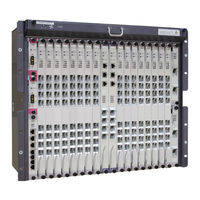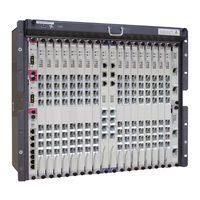Huawei SmartAX MA5608T GPON OLT Manuals
Manuals and User Guides for Huawei SmartAX MA5608T GPON OLT. We have 5 Huawei SmartAX MA5608T GPON OLT manuals available for free PDF download: Configuration Manual, Hardware Description, Quick Installation Manual
Huawei SmartAX MA5608T Configuration Manual (1979 pages)
Access Module
Table of Contents
-
-
Checking the Log215
-
Script Making218
-
-
Configuring AAA251
-
-
Configuring Vags376
-
-
-
Basic Concepts572
-
-
Basic Concepts750
-
-
Basic Concept840
-
Verifying Services1044
-
Verifying Services1067
-
Verifying Services1094
-
-
Basic Concept1099
-
ONU Capability Sets1103
-
Verifying Services1163
-
Verifying Services1208
-
Gateway Networking1212
-
Verifying Services1254
-
Adding Onus to OLT1262
-
Verifying Services1272
-
-
Basic Concepts1276
-
Adding Onus to OLT1296
-
Verifying Services1310
-
Adding Onus to OLT1314
-
Verifying Services1321
-
Adding Onus to OLT1326
-
Verifying Services1337
-
Adding Onus to OLT1339
-
Verifying Services1352
-
Adding Onus to OLT1355
-
Verifying Services1368
-
Adding Onus to OLT_B1374
-
Verifying Services1382
-
-
Basic Concepts1386
-
Adding Onus to OLT1426
-
Verifying Services1436
-
Adding Onus to OLT1442
-
Verifying Services1455
-
Adding Onus to OLT1459
-
Verifying Services1474
-
Verifying Services1489
-
Verifying Services1503
-
Verifying Services1509
-
Verifying Services1520
-
Verifying Services1528
-
Verifying Services1539
Advertisement
Huawei SmartAX MA5608T Hardware Description (977 pages)
Multiservice Access Module
Brand: Huawei
|
Category: Control Unit
|
Size: 44.64 MB
Table of Contents
-
1 Cabinet
21-
Appearance21
-
Cable Hole37
-
ESD Jack38
-
Air Filter39
-
Grounding42
-
Appearance52
-
Cable Hole61
-
ESD Jack63
-
Air Filter64
-
Grounding67
-
Appearance75
-
Cable Hole79
-
ESD Jack80
-
Air Filter81
-
Grounding84
-
-
Appearance89
-
ESD Jack104
-
Grounding104
-
Heat Dissipation105
-
Appearance106
-
Configuration107
-
Appearance108
-
Configuration111
-
ESD Jack124
-
Grounding125
-
Heat Dissipation126
-
Function132
-
Indicators133
-
Heat Dissipation134
-
Appearance135
-
Configuration138
-
Fan Tray(FMCA)140
-
Fan Tray (FCBI)144
-
ESD Jack147
-
Air Filter148
-
Grounding150
-
Heat Dissipation151
-
Appearance151
-
Configuration154
-
Fan Tray156
-
ESD Jack158
-
Grounding158
-
Heat Dissipation160
-
3 Board
161-
Board Overview163
-
Board Structure163
-
Board Dimensions165
-
Board Label168
-
Daughter Board258
-
SPU Board343
-
Voice Board479
-
ADSL2+ SPL Board785
-
VDSL2 SPL Board822
-
Extension Board853
-
Filler Panel857
-
Huawei SmartAX MA5608T Hardware Description (65 pages)
Multiservice Access Module
Brand: Huawei
|
Category: Control Unit
|
Size: 5.3 MB
Table of Contents
-
Cabinet15
-
Appearance16
-
Cable Hole32
-
ESD Jack33
-
Air Filter34
-
Grounding38
-
Ventilation45
-
Appearance48
-
Cable Hole58
-
ESD Jack60
-
Air Filter61
-
Appearance61
-
Grounding64
Advertisement
Huawei SmartAX MA5608T Quick Installation Manual (15 pages)
Brand: Huawei
|
Category: Network Hardware
|
Size: 5.57 MB
Table of Contents
Huawei SmartAX MA5608T Hardware Description (16 pages)
Multi- service Access Module
Brand: Huawei
|
Category: Network Hardware
|
Size: 4.47 MB
Table of Contents
Advertisement




